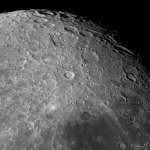
|
You entered: space observations
 Tycho and Clavius
Tycho and Clavius
5.08.2021
South is up in this detailed telescopic view across the Moon's rugged southern highlands. Captured on July 20, the lunar landscape features the Moon's young and old, the large craters Tycho and Clavius.
|
January February March April May |
|||||||||||||||||||||||||||||||||||||||||||||||||